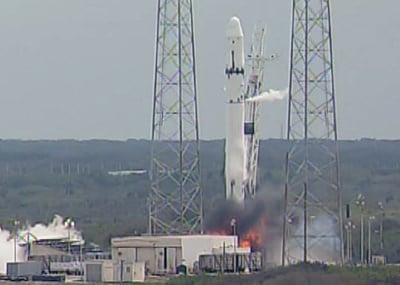[/caption]
Updated at 9:40 EST Tuesday:
SpaceX
just released the official word on what happened with Tuesday's 3.5 second test-fire of the Falcon 9 rocket. The test aborted immediately after it started, and a a spin start system failure forced the early shutdown. The Falcon 9 sits on Launch Complex 40 at Cape Canaveral Air Force Station, and from the Kennedy Space Center press site, (about 4 miles away) a muffled bang was heard at the time of ignition, 1:41 pm EST. "Today SpaceX performed our first Static Fire for the Falcon 9 launch vehicle," said Emily Shankin from SpaceX in a press release. "We counted down to an T-2 seconds and aborted on Spin Start. Given that this was our first abort event on this pad, we decided to scrub for the day to get a good look at the rocket before trying again. Everything looks great at first glance."
An online webcam on
Spaceflightnow.com
showed a brief flash and a small cloud of smoke, and then nothing. Other observers at the site said it appeared as if flight computers detected a problem and automatically shut down the engines before the test was completed. The test-firing is considered a major objective towards the first launch of the Falcon 9, now tentatively scheduled for March 22, but SpaceX officials say launch is more likely to occur in April.
Here's the rest of SpaceX's press release:
We completed pad preps on time and with good execution. The integrated countdown with the range included holdfire checks, S- band telemetry, C-band, and FTS simulated checks. We completed helium, liquid oxygen (LOX), and fuel loads to within tenths of a percent of T-zero conditions. Tanks pressed nominally and we passed all Terminal count, flight software, and ground software abort checks right down to T-2 seconds. We encountered a problem with the spin start system and aborted nominally.
As part of the abort, we close the pre-valves to isolate the engines from the propellant tank and purge the residual propellants. The brief flames seen on the video are burn off of LOX and kerosene on the pad. The engines did not ignite and there was no engine fire.
We detanked and safed the vehicle and launch pad. Preliminary review shows all other systems required to reach full ignition were within specification. All other pad systems worked nominally. Inspections will be complete tonight. Tomorrow will consist of data review and procedure updates. Commodities will be replenished tomorrow including TEA TEB load, LOX and helium deliveries.
We'll look to do the next static fire attempt in three or four days.
The Falcon 9 rocket measures 47 meters long (154 feet) and 4 meters (12 feet) wide, and for the upcoming test launch the payload will be a dummy of the company's Dragon capsule being developed to carry equipment to the International Space Station for NASA.
The nine Merlin 1C engines will produce about 825,000 pounds of total thrust, about four times the power of a 747 jumbo jet at full throttle. The engines consume about 3,200 pounds of kerosene and liquid oxygen propellants per second, according to SpaceX.
 Universe Today
Universe Today
